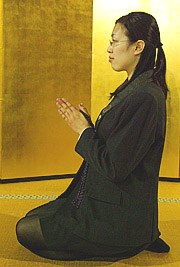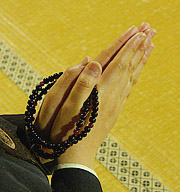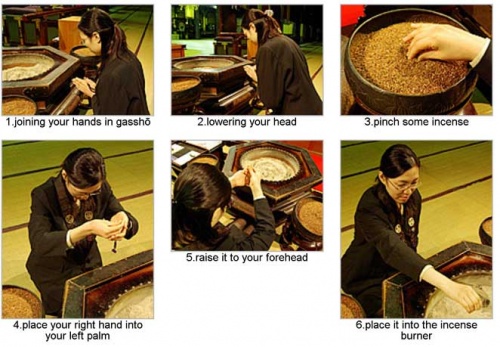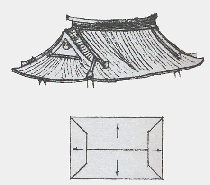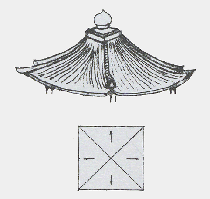About Buddhist Temples and Jōdo Shū
- See also :
- See also :
When Visiting a Temple
Gasshō (Joining Your Hands In Prayer)
In front of your chest, join both of your hands together, leaving no space between your fingers, and tilt them slightly diagonally. This is how prayers were done in ancient India.
Juzu (Buddhist Rosary Beads)
Bring a set of juzu (rosary beads) with you when you visit a temple. Originally, the juzu were used to count the number of times the nembutsu was chanted. With your hands in gasshō, place the juzu between your thumbs and index finger and let the tassel hang down. When your hands are not in gasshō, hand it from your left hand. There are also miniature juzu bands that you can wear on your arm.
How to Pray
Jōdo Shū(Pure Land Sect) practice revolves around chanting Namu Amida Butsu (I entrust myself to Amida). The most basic chanting method is called the jūnen (chanting ten times). Here is how to do it: first, chant namu amida bu eight times and then catch your breath. Then, chant namu amida butsu namu amida bu, and then lower your head on the last recitation. By the way, although it is customary to clap your hands at a Shinto shrine, this is not done at a Buddhist temple.
Shōkō (Offering Incense)
In Buddhism, we burn incense and offer it to the Buddha. Sit in a kneeling position in front of the incense burner, and after joining your hands in gasshō (see above) and lowering your head, pinch some incense with your right thumb, index, and middle finger. Then, place your right hand into your left palm, raise it to your forehead, then place it into the incense burner. Finally, join your hands once more in gasshō and lower your head.
Terminology
Amida Butsu (Amitabha)
In Jōdo Shū, we worship Amida. Amida, in keeping with the original vow (see below) he made during his training, will save all sentient beings who chant Namu Amida Butsu (I take refuge in Amida) and bring them to the Pure Land, where he resides. At Chion-in, Amida is enshrined in the Amida-dō (Amida Hall) and Shūedō (assembly hall, currently under construction). Amida is a transliteration from Sanskrit. According to the Amidakyō (The Amida Sutra), the origins of his name lie in the fact that he has infinite life (amitayus) and is a source of infinite light (amitābha).
Hongan (The Original Vow)
In Mahayana Buddhism (the type of Buddhism common in Japan, China, Korea and Vietnam), bodhisattvas (one who has taken a pledge to save sentient beings) make a series of vows during their training in order to attain enlightenment. Upon attaining enlightenment, the vow that they made in the past is called their “original vow.” During his training period, Amida made 48 vows. In one of them, which can be found in the Muryōjukyō (The Buddha of Infinite Life Sutra), Amida pledged: “If I become enlightened, I will save all sentient beings who wish with their hearts to be born in my land.” The Jōdo Shū chants Amida’s name based on this original vow.
Namu Amida Butsu (I Take Refuge in Amida)
Namu is the Japanese transliteration of the Sanskrit word for “to take refuge,” so Namu Amida Butsu means “I take refuge in Amida.” According to the Kamuryōjukyō (The Meditation on the Buddha of Infinite Life Sutra ), those who chant “Namu Amida Butsu” will be freed from their sins and be reborn in the Pure Land.
Kannon Bosatsu
In Pure Land thought, Kannon (also known as Kanzeon Bosatsu and Kanjizai Bosatsu) along with Seishi Bosatsu (see below) serve as attendants to Amida. Kannon symbolizes compassion.
Seishi Bosatsu
Seishi Bosatsu, like Kannon Bosatsu, also serves as an attendant to Amida. Seishi symbolizes wisdom. Shōmyō (Musical Chanting of Sutras)
Shōmyō is the melodic chanting of a sutra. This practice originated in India and came to Japan via China. Shōmyō is the foundation for later forms of Japanese music, such as naniwabushi and enka.
Karayō (Chinese Style)
Also known as zenshūyō (Zen style), this style of Zen temple architecture came from China. One of the distinctive features of this style is that large stone slabs are placed directly on the earthen floor and these serve as the foundation for the temple’s pillars. Later, this style of architecture was also incorporated into castles and regular homes.
Wayō (Japanese Style)
A style of Chinese temple architecture modified for Japan’s earthquake-prone environment. In particular, the parts where the pillars and beams meet are specially reinforced. Chion-in has buildings that combine both the karayō and wayō styles of architecture.
Kanō School
This is a school of painting founded in the late 15th century by Kanō Masanobu, who served as the official painter to the Muromachi shogun. The Kanō School combines the techniques of both suibokuga (India ink painting) and yamato-e (Japanese style painting) and they greatly contributed to the development of shōhekiga (wall paintings) such as fusuma-e (sliding door paintings) from their time onward. The Kanō School also served the Tokugawa shoguns and were an influential force in Japanese painting until the 1860s.
Irimoya-zukuri (Hip and Gable Style)
A style of temple roof design, the moya (part of the roof that protects the central part of the temple) is in the kirizuma-zukuri style, where the roof has two ridges). The entire moya is surrounded by hisashi (eaves).
Hōgyō-zukuri (Tiled Roof)
This is a style of temple roof design which consists of four slants that descend from the middle of a square. Often, at the very top of the roof, there will be a metal ball called a hōju (treasure ball).
Mandala (Pictorial Depiction of the Buddhist Cosmos)
A mandala depicts the teachings of Buddhism in a symbolic manner, laying out the various Buddhas and other Buddhist deities using geometric shapes. There is a mandala called the Taima Mandala, which presents the contents of the Kanmuryōjukyō (Sutra of Contemplation of Eternal Life), one of Jōdo Shū’s basic sutras. In the middle of the mandala, the Pure Land is magnificently depicted. In later years, many copies of the mandala have been made based on the 8th century originally held at the Taimadera temple.
